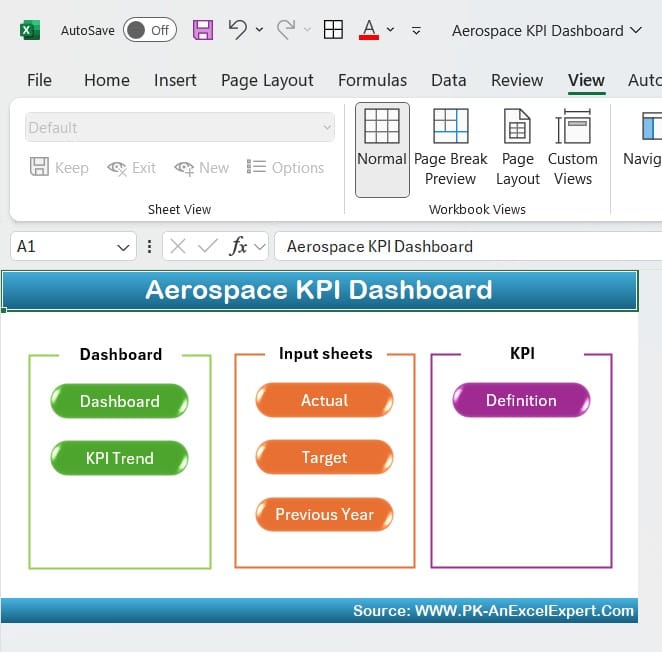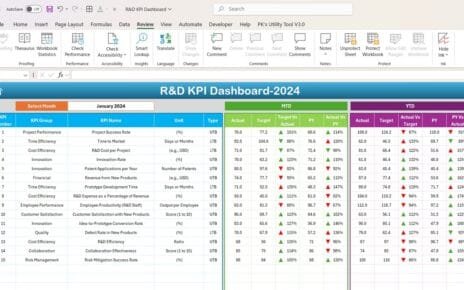In the fast-paced, competitive world of aerospace, staying ahead means constantly striving for operational excellence. One of the best ways to achieve this is by using an Aerospace KPI Dashboard. This powerful tool allows companies to monitor key performance indicators (KPIs) in real-time, enabling decision-makers to identify areas for improvement, optimize performance, and drive business growth.
Whether you’re overseeing aircraft production, maintenance, or airspace management, an Aerospace KPI Dashboard offers a clear, actionable view of performance across various departments. In this guide, we’ll dive into the essential KPIs to track, the features that make a dashboard effective, and best practices to ensure your dashboard delivers maximum value.
Click to buy Aerospace KPI Dashboard in Excel
What is an Aerospace KPI Dashboard?
Simply put, an Aerospace KPI Dashboard is a visual tool that allows companies to track, monitor, and analyze their most important operational metrics. It consolidates data from multiple areas such as production, maintenance, safety, and customer service and presents it in an easy-to-understand format.
By organizing this data effectively, a well-designed dashboard helps aerospace leaders make informed, data-driven decisions that enhance performance, reduce costs, and maintain the highest safety standards. A solid dashboard typically includes KPIs related to:
Why is an Aerospace KPI Dashboard Important?
In the aerospace industry, where safety, efficiency, and reliability are paramount, tracking the right metrics is crucial. Here’s how an Aerospace KPI Dashboard can make a significant impact:
Monitor performance across all areas of the business in real-time
Spot inefficiencies early and take corrective actions
Ensure compliance with safety standards and industry regulations
Make informed decisions that improve operational and financial outcomes
Enhance customer satisfaction by fine-tuning service delivery
With clear visibility into key metrics, an Aerospace KPI Dashboard not only helps optimize daily operations but also supports long-term strategic improvements.
Key Features of the Aerospace KPI Dashboard
To ensure your Aerospace KPI Dashboard is effective, it should include the following features:
-
Home Sheet
The Home Sheet acts as the central hub, providing easy navigation to the other sections of the dashboard. Users can quickly jump to the relevant areas they need to monitor.

-
Dashboard Sheet Tab
Here is where most of the KPI tracking takes place. The dashboard displays Month-to-Date (MTD) and Year-to-Date (YTD) data, with color-coded indicators (e.g., up/down arrows) to make performance trends clear.

Click to buy Aerospace KPI Dashboard in Excel
-
KPI Trend Sheet Tab
The KPI Trend Tab helps you track KPI performance over time. By visualizing the data, it’s easier to spot trends—whether things are improving, stagnating, or declining.

Click to buy Aerospace KPI Dashboard in Excel
-
Actual Numbers Sheet Tab
This tab is where users enter actual data for both MTD and YTD. It’s a place for recording the current data and comparing it against historical figures.

Click to buy Aerospace KPI Dashboard in Excel
-
Target Sheet Tab
The Target Sheet Tab allows teams to set monthly targets for each KPI, ensuring everyone stays aligned with the organization’s goals.

Click to buy Aerospace KPI Dashboard in Excel
-
Previous Year Numbers Sheet Tab
The Previous Year Tab lets users compare current data with that from the previous year. This historical view helps assess long-term progress and identify areas that need improvement.

Click to buy Aerospace KPI Dashboard in Excel
KPI Definition Sheet Tab
The KPI Definition Sheet provides clear explanations for each metric, including the formula, unit of measurement, and purpose. This ensures everyone understands the KPIs being tracked.

Click to buy Aerospace KPI Dashboard in Excel
Advantages of Using an Aerospace KPI Dashboard
Adopting a KPI dashboard in aerospace comes with several key benefits:
- Real-Time Monitoring: With a real-time dashboard, you can track your operations and quickly address any issues that arise, enabling faster decision-making.
- Improved Operational Efficiency: KPIs like cost per unit, fuel efficiency, and on-time delivery help companies pinpoint inefficiencies and make adjustments to optimize processes.
- Enhanced Safety: By tracking safety KPIs such as the safety incident rate, companies can focus on improving safety protocols and compliance.
- Data-Driven Decisions: The dashboard consolidates data from multiple departments, making it easier to make informed decisions that improve company-wide performance.
- Customer Satisfaction: By monitoring customer satisfaction KPIs, aerospace companies can refine their services and build stronger customer loyalty.
Opportunities for Improvement in an Aerospace KPI Dashboard
While the Aerospace KPI Dashboard is a powerful tool, there’s always room for improvement:
- Data Accuracy: For effective decision-making, accurate data is essential. Be sure to regularly update and verify the dashboard’s data to ensure it reflects real performance.
- Customization: Since each aerospace operation is unique, customizing the dashboard to reflect specific needs will make it more relevant and useful.
- System Integration: Integrating the dashboard with other systems like ERP, CRM, or Maintenance Management Systems can provide a broader view of operations and improve workflow efficiency.
- Employee Training: Make sure all employees are trained on how to use the dashboard effectively. This ensures they can interpret the data and act on it appropriately.
Best Practices for Using an Aerospace KPI Dashboard
To get the most out of your Aerospace KPI Dashboard, follow these best practices:
- Set Clear, Measurable Goals
Define specific, measurable targets for each KPI. This helps keep everyone focused and ensures progress is being made.
- Update the Dashboard Regularly
Keep the dashboard updated, ideally in real time, so that the data remains relevant and useful for decision-making.
- Use Visual Indicators
Incorporate color-coded arrows or other visual cues to quickly indicate whether KPIs are on track. This makes performance easier to interpret at a glance.
- Engage Employees
Encourage employees to actively use the dashboard and participate in performance discussions. This fosters a culture of accountability and continuous improvement.
Frequently Asked Questions (FAQ)
Q. What is an Aerospace KPI Dashboard?
An Aerospace KPI Dashboard is a tool that allows aerospace companies to track and analyze key performance indicators in real-time, providing insights to improve performance and safety.
Q. Why is tracking KPIs important in aerospace?
Tracking KPIs helps aerospace companies measure performance, identify inefficiencies, and make data-driven decisions that boost efficiency, safety, and customer satisfaction.
Q. How often should the Aerospace KPI Dashboard be updated?
Ideally, the dashboard should be updated in real-time or at least regularly to ensure the data stays relevant and actionable.
Q. Can the Aerospace KPI Dashboard be customized?
Yes, the dashboard can be customized to meet the specific needs of your aerospace operation, allowing for targeted performance tracking.
Conclusion
An Aerospace KPI Dashboard is an indispensable tool for driving operational excellence in the aerospace industry. By tracking the right KPIs and following best practices, aerospace companies can gain valuable insights that improve efficiency, safety, and customer satisfaction. Whether you’re managing aircraft downtime, monitoring fuel efficiency, or boosting customer satisfaction, the right dashboard helps keep your organization on track to meet its goals and succeed in the competitive aerospace market.
Visit our YouTube channel to learn step-by-step video tutorials
Click to buy Aerospace KPI Dashboard in Excel



